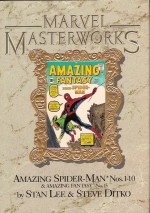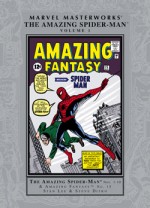

By Stan Lee & Steve Ditko (Marvel)
ISBN: 0-87135-305-9, 2nd edition 978-0-7851-1181-8
Marvel is often termed “the House that Jack Built†and King Kirby’s contributions are undeniable and inescapable in the creation of a new kind of comicbook story-telling, but there was another unique visionary toiling at Atlas-Comics-as-was: one whose creativity and even philosophy seemed diametrically opposed to the bludgeoning power, vast imaginative scope and clean, broad lines of Kirby’s ever-expanding search for the external and infinite.
Steve Ditko was quiet and unassuming, voluntarily diffident to the point of invisibility though his work was both subtle and striking: innovative, meticulously polished, always questing for detail, he ever explored the man within. He found heroism – and humour and ultimate evil – all contained within the frail but noble confines of human scope and consciousness. His drawing could be oddly disquieting… and, when he wanted, almost creepy.
Drawing extremely well-received monster and mystery tales for Stan Lee, Ditko had been given his own title. Amazing Adventures/Amazing Adult Fantasy featured a subtler brand of yarn than Rampaging Aliens and Furry Underpants Monsters and the ilk which, though individually entertaining, had been slowly losing traction in the world of comics ever since National/DC had successfully reintroduced costumed heroes. Lee & Kirby had responded with Fantastic Four and the ahead-of-its-time Incredible Hulk but there was no indication of the renaissance to come when the already cancelled Amazing Fantasy #15 cover featured a brand new and rather creepy adventure character.
In 11 captivating pages ‘Spider-Man!’ told the parable of Peter Parker, a smart but alienated kid bitten by a radioactive spider on a High School science trip. Discovering he had developed arachnid abilities which he augmented with his own natural engineering genius, he did what any lonely, geeky nerd would do when given such a gift – he tried to cash in for girls, fame and money.
Making a costume to hide his identity in case he made a fool of himself, Parker became a minor celebrity – and a self-important one. To his eternal regret, when a thief fled past he didn’t lift a finger to stop him, only to find when he returned home that his uncle Ben had been murdered.
Crazy for vengeance, Parker hunted the assailant who had made his beloved Aunt May a widow and killed the only father he had ever known, only to find that it was the felon he couldn’t be bothered with. His social irresponsibility had led to the death of the man who raised him and the boy swore to always use his powers to help others…
It wasn’t a new story, but the setting was one familiar to every kid reading it and the artwork was downright spooky. This wasn’t the gleaming high-tech world of moon-rockets, giant monsters and flying cars – this stuff could happen to anybody…
Amazing Fantasy #15 came out the same month as Tales to Astonish #35 (cover-dated September 1962) – the first to feature the Astonishing Ant-Man in costumed capers, but it was the last issue of Ditko’s Amazing playground.
However the tragic last-ditch tale had struck a chord with the reading public and by Christmas a new comicbook superstar was ready to launch in his own title, with Ditko eager to show what he could do with his first returning character since the demise of the Charlton hero Captain Atom (see Action Heroes Archive volume 1).
Holding on to the “Amazing†prefix to jog reader’s memories, the bi-monthly Amazing Spider-Man #1 had a March 1963 cover-date and two complete stories. It prominently featured the Fantastic Four and took the readers by storm. The opening tale, again simply entitled ‘Spider-Man!’, recapitulated the origin whilst adding a brilliant twist to the conventional mix.
The wall-crawling hero was feared and reviled by the general public thanks in no small part to J. Jonah Jameson, a newspaper magnate who pilloried the adventurer from spite and for profit. With time-honoured comicbook irony, Spider-Man then had to save Jameson’s astronaut son John from a faulty space capsule…
The second yarn ‘Vs the Chameleon!’ found the cash-strapped kid trying to force his way onto the roster – and payroll – of the Fantastic Four whilst elsewhere a spy perfectly impersonated the web-spinner to steal military secrets, in a stunning example of the high-strung, antagonistic crossovers and cameos that so startled the jaded kids of the early 1960s.
Heroes just didn’t act like that…
With the second issue our new champion began a meteoric rise in quality and innovative storytelling. ‘Duel to the Death with the Vulture!’ found Parker chasing a flying thief as much for profit as justice. Desperate to help his aunt make ends meet, Spider-Man began to take photos of his cases to sell to Jameson’s Daily Bugle, making his personal gadfly his sole means of support.
Along with comedy and soap-operatic melodrama Ditko’s action sequences were imaginative and magnificently visceral, with odd angle shots and quirky, mis-balanced poses adding a vertiginous sense of unease to fight scenes. But crime wasn’t the only threat to the world and Spider-Man was just as (un)comfortable battling “aliens†in ‘The Uncanny Threat of the Terrible Tinkerer!’
Amazing Spider-Man #3 introduced possibly the apprentice hero’s greatest enemy in ‘Versus Doctor Octopus’, a full-length epic wherein a dedicated scientist survived an atomic accident only to find his self-designed mechanical tentacles permanently grafted to his body. Power-mad, Otto Octavius initially thrashed Spider-Man, sending the lad into a depression until an impromptu pep-talk from the Human Torch galvanized Spider-Man to one of his greatest victories.
‘Nothing Can Stop… the Sandman!’ was another instant classic wherein a common thug who had gained the power to transform to sand (another pesky nuclear snafu) invaded Parker’s school, and had to stopped at all costs whilst issue #5 found the web-spinner ‘Marked for Destruction by Dr. Doom!’ – not so much winning as surviving his battle against the deadliest man on Earth. Presumably he didn’t mind too much as this marked the transition from bi-monthly to monthly status for the series. In this tale Parker’s social nemesis, jock bully Flash Thompson, first displayed depths beyond the usual in contemporary comicbooks, beginning one of the best love/hate buddy relationships in popular literature…
Sometime mentor Dr. Curtis Connors debuted in #6 when Spidey came ‘Face-to-face with… The Lizard!’ as the wallcrawler fought his battle far from the concrete canyons and comfort zone of New York – specifically in the murky Florida Everglades. Parker was back in the Big Apple in #7 to breathtakingly tackle ‘The Return of the Vulture’.
Fun and youthful hi-jinks were a signature feature of the series, as was Parker’s budding romance with “older woman†Betty Brant, Jameson’s PA at the Daily Bugle. Youthful exuberance was the underlying drive in #8′s lead tale ‘The Living Brain!’ an ambulatory robot calculator that threatened to expose Spider-Man’s secret identity before running amok at beleaguered Midtown High, just as Parker was finally beating the stuffings out of school bully Flash Thompson.
This 17 page joy was accompanied by ‘Spiderman Tackles the Torch!’ (a 6 page vignette drawn by Jack Kirby and inked by Ditko) wherein a boisterous wall-crawler gate-crashed a beach part thrown by the flaming hero’s girlfriend… with explosive consequences.
Amazing Spider-Man #9 was a qualitative step-up in dramatic terms as Aunt May was revealed to be chronically ill – adding to Parker’s financial woes – and the action was supplied by ‘The Man Called Electro!’ a super-criminal with grand aspirations. Spider-Man was always a loner, never far from the streets and small-scale-crime, and with this tale wherein he also quells a prison riot single handed, Ditko’s preference for tales of gangersterism began to show through; a predilection confirmed in #10′s ‘The Enforcers!’ a classy mystery where a masked mastermind known as the Big Man used a position of trust at the Bugle to organize all the New York mobs into one unbeatable army against decency. Longer plot-strands were also introduced as Betty Brant mysteriously vanished (her fate to be revealed in the next issue and here the second Mighty Marvel Masterworks volume), but most fans remember this one for the spectacularly climactic seven-page fight scene in an underworld chop-shop that has still never been topped for action-choreography.
These immortal epics are available in numerous formats (including softcover editions of the luxurious and enticing hardback under review here), but for a selection that will survive the continual re-readings of the serious, incurable fan there’s nothing to beat the substantial full-colour feel of these Marvellous Masterwork editions.
© 1962, 1963, 1964, 1987, 2003 Marvel Characters, Inc. All Rights Reserved.
